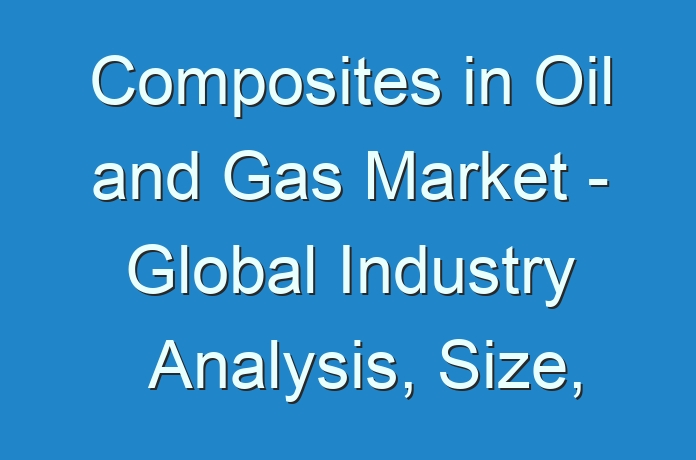
Composites in Oil and Gas Market: Overview
The oil & gas industry needs to meet certain technical, technological, and economic requirements. This is especially observed in materials employed in construction, which are expected to withstand corrosion, fatigue, and weight. These factors contribute to increased risk and cost of offshore projects.
Composites are used due to their unique properties, which make them suitable for demanding applications in the oil & gas industry. They have the advantage of being low in weight, which eliminates the need for large and exorbitant buoyancy tanks. Composites are inexpensive to install, extremely corrosion-resistant, and well-suited to increased operating pressures.
Composites are made by matrix combination of different materials. The most commonly used composites are formed by combining epoxy, phenolic, or polymer (polyethylene, poly-vinyl-denefluoride, and polyamide) matrix with glass fibers, carbon fibers, or aramid fibers.
Request a Sample-
https://www.transparencymarketresearch.com/sample/sample.php?flag=S&rep_id=17315
Composites in Oil and Gas Market: Applications
Glass-fiber reinforced polymer (GFRP) composites are used in piping systems for applications such as oil exploration, desalination, chemical plants, fire mains, dredging, and portable water. They enable the piping systems to withstand highly corrosive fluids at various temperatures, pressures, and in adverse weather and soil conditions.
Composite grinds/gratings perform better than traditional, metallic grinds/gratings, due to their superior properties under harsh environments in the chemical process industry. They are preferred due to their ability to overcome limitations with respect to weight, corrosion resistance, durability, and lifecycle costs.
Composite ladders are stronger than wood or aluminum and they do not rot, corrode, or absorb water.
During the construction of a riser (a pipeline that connects the rig of water surface to the well bore at seabed), thermoplastic polymer matrix reinforced with glass or carbon fibers is used. This matrix is wound around its steel reinforcement, which drastically reduces its weight. In some cases, epoxy matrix reinforced with carbon fibers may be used.
In the construction of pipe systems for fluid transport and storage tanks, fiberglass composites are used. They are formed by combining polymer matrix (generally, epoxy matrix and vinyl ester matrix) with glass fibers.
Tubings are usually produced from GRE pipes or GRE pipes reinforced with carbon steel, which provide resistance to high pressure in down-hole applications.
Request for covid19 impact analysis –
https://www.transparencymarketresearch.com/sample/sample.php?flag=covid19&rep_id=17315
Composites in Oil and Gas Market: Trends
There has been major advances in the fields of composite pipe work and fluid handling. Cost-cutting due to composites replacing steel piping in retrofit applications is a major driver for the market. Cost advantage can also be witnessed during the manufacturing process of risers, tubings, and storage and transport systems in offshore platforms when composites are used in place of expensive corrosion-resistant metals. Another important propellant for the market is amplified longevity of new, reliable, safe, and cost-effective construction, which can withstand severe conditions anticipated in an offshore environment.
Composites in Oil and Gas Market: Segmentation
In terms of matrix materials, the composites in oil and gas market can be segmented into six segments: epoxy, phenolic, polymers, glass fibers, carbon fibers, and aramid fibers.
Based on product type, the market has been divided into: glass reinforced plastic (GRP), glass reinforced epoxy resin (GRER), glass reinforced vinyl ester (GRVE), and reinforced thermoplastic (RTP).
In terms of application, the market has been segmented into: piping systems, grinds/gratings, ladders, flexible tubes, composite risers, and caissons & pull tubes.
Pre-Book now-
https://www.transparencymarketresearch.com/checkout.php?rep_id=17315<ype=S
Composites in Oil and Gas Market: Region-wise Outlook
In terms of volume, the U.S. and China are prominent consumers of composites. North America is likely to remain the key region owing to the rising number of natural gas infrastructure projects and growing awareness about advantages of composite materials in the region. The market in the region is expanding also due to the rise in demand for high-performance lightweight materials and new products developed using them.
Composites in Oil and Gas Market: Key Players
Key players operating in the composites in oil and gas market include Creative Composites Ltd., National Composites Center, Pipex Limited, and Solent Composite Systems Ltd., CIP Composites, Magnum Oil Tools, Forum Energy Technologies, GE Oil & Gas, and Magma Global Limited.
Companies in the Composites in Oil and Gas market have increasingly shifted gears with wide application of digital technology across the continuum, from raw material sourcing to manufacturing to generation of final output, to warehousing to final distribution operations. Among the various affects, the market is witnessing new growth economics due to thinning of line between specialty and commodity businesses that are associated with the larger ecosystem. At the same time, new growth parameters are being vigorously being debated as industry stakeholders put greater emphasis on the circular economy processes.
More Trending Report-





